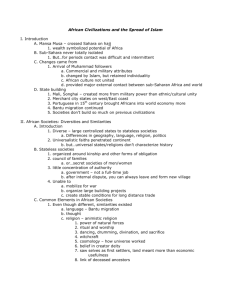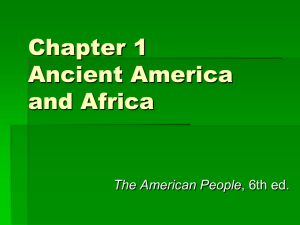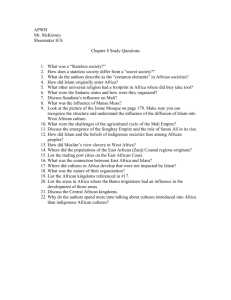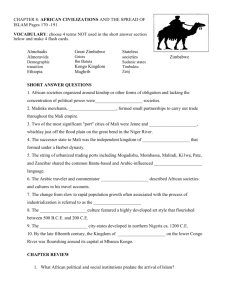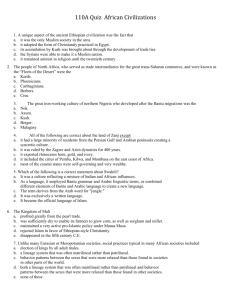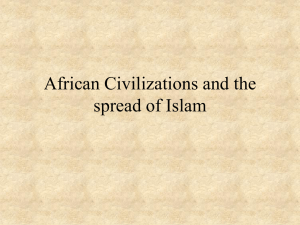8 Outline 4th period
advertisement
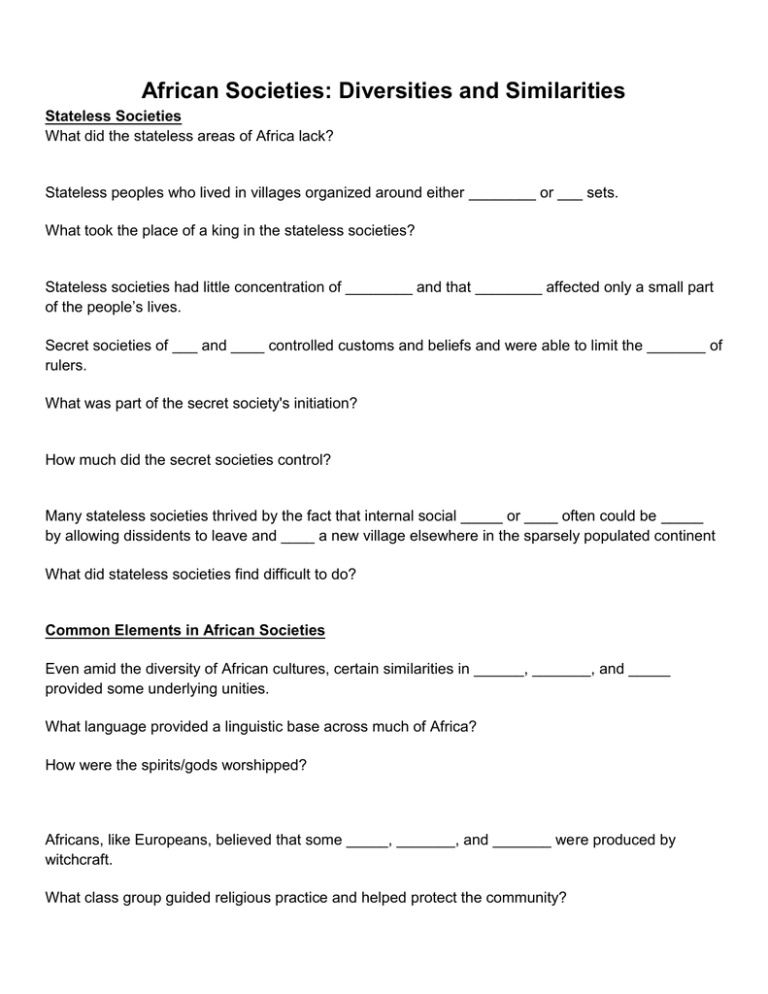
African Societies: Diversities and Similarities Stateless Societies What did the stateless areas of Africa lack? Stateless peoples who lived in villages organized around either ________ or ___ sets. What took the place of a king in the stateless societies? Stateless societies had little concentration of ________ and that ________ affected only a small part of the people’s lives. Secret societies of ___ and ____ controlled customs and beliefs and were able to limit the _______ of rulers. What was part of the secret society's initiation? How much did the secret societies control? Many stateless societies thrived by the fact that internal social _____ or ____ often could be _____ by allowing dissidents to leave and ____ a new village elsewhere in the sparsely populated continent What did stateless societies find difficult to do? Common Elements in African Societies Even amid the diversity of African cultures, certain similarities in ______, _______, and _____ provided some underlying unities. What language provided a linguistic base across much of Africa? How were the spirits/gods worshipped? Africans, like Europeans, believed that some _____, _______, and _______ were produced by witchcraft. What class group guided religious practice and helped protect the community? What did African religion provide? Describe the belief that many African peoples shared. The ancestors were viewed as the _________________ and ____________ of the land. What did they believe would be ensured through the ancestors? Who had a major role in dealing with the gods? Deceased ancestors were thought to be a ______________ between the living relatives and the spirit world. Explain what the system of belief for the ancestors and gods was connected to and what it withstood. What had been established before or during the postclassical period? Specialization encouragedThe ___________ and _________________________ were important ingredients of African society. Trade- handled by who & with who did it mainly increase African states benefited from ________________________________________ What disadvantages did the African states have in trading? Describe the outcomes of international trade. By 1500, Africa may have had ____ to ____ million inhabitants. The Arrival of Islam in North Africa Africa north of the Sahara had long been part of the world of __________________. What two cities (when, where) played a part in the classical world? What was the aftermath of Egypt after the age of the Pharaohs? Toward the end of the Roman Empire, ________________ had taken a firm hold in Mediterranean Africa. Describe the warring period between the Vandals and Byzantines. With the rise of _____________, ties between North Africa across the Sahara to the rest of Africa became ________________. The path of Muhammad’s followers between 640 and 700 CEMuslims ruled ___________ in 670 CE. What did the Romans use to call Africa? What did the Arabs use this name for? Muslim advance in the west- who, when, where, what happened The message of _____________ settled among the people of North Africa. What did the Abbasid provide that increased conversion? Describe what happened after the destruction of the unity. The Berbers formed cities like _______ in Morocco and ___________ in opposition to the nearby Arab states. A puritanical reformist movement, whose followers were called ____________, grew in the Western Sahara. In 1130, another group, called the ____________, did the same. What fundamental teaching of Islam made acceptance of conquerors and new rulers easier? Islamic tradition unites the powers of the _________ and ___________ in the person of the ruler or caliph. Social ______________ remained important to Islamicized societies, and ethnic _____________ also divided the believers. For example, the fine for killing a man was ___________ that for killing a woman. The Christian Kingdoms: Nubia and Ethiopia What did the wave of Arab conquests across northern Africa do? How did the Christians in Egypt, the Copts, interact with the Byzantine Empire, and on what issues did their cultures split? Why were the Copts able to maintain their faith even after Egypt was conquered by Muslims? The ______________ ______________ that grew from Axum was the most important African Christian outpost. Why was the Ethiopian Kingdom so isolated? What did King Lalibela accomplish? In the 13th and 14th centuries, an Ethiopian state that traced its origins back to the marriage of ____________ and __________ emerged. What did this nation do and what languages did they speak? Who arrived at Massawa by the Red Sea in 1542, and what did they do? After the Portuguese failed to bring Ethiopian Christianity into the Catholic Church, Ethiopia remained _____________, _____________, and fiercely ________________. Kingdoms of the Grasslands In the ________________, several powerful states emerged that combined __________________. The Kingdoms of what 3 states were African adaptations of Islam? __________ ___________ ___________ Africa had 3 important “coasts” of contact: ________________ ________________ _______________________________ How did Ghana form? Why did the Sahel become an important point of exchange? How did the African states take advantage of their location along the coast? What were the disadvantages of the location of the African states on the open plains? ________ were introduced from Asia to the _________ between the first and fifth centuries? Why couldn’t the animals survive in the humid forests of the Sahel? What is the Sahel? What was the point of exchange between the forest to north and South Africa? ________ rose to power by taxing the ____ and ____ exchange within its borders. By what century was Ghana at the height of its power? What also happened in the 10th century? Ghana could ________________ many times the size of what? - __________________________________________________________. _________________ armies invaded ___________ from north Africa in 1076. Although the ___________ survived, its ___________ was in decline, so at the beginning of the ___ century new _______ had risen in the _________________ to take off its place of leadership. Who were the Sudanic states led by? How did rulers support Islam and what was done in return? _____________ was the basis of society in the Mali empire. Define griots: Sundiata became the ____________. Who dies in the year 1260? Who was the most famous successor of Sundiata was _____________________. What did he do in 1324? What did Mansa Musa bring back from Mecca? What were the 2 “port” cities? Where was the library and university located and who studied there? The most lucrative trade at that time was: Life wasn’t centered on the __________, ____________, or ________________, but rather on the ________________________ and village. What percentage of farmers lived solely on (substinence) farming and what made this difficult? Define polygamy: SONGHAY KINGDOM What 2 objects became symbols of the common people of the savanna states? What 3 methods were used by them to provide food for themselves and others? What happened when the power of Mali began to decrease? What areas did the people of Songhay dominate? The society of Songhay was made up of “___________________________”, which are ________________________, and “____________________________”, which are __________________. Songhay began to form when and under what dynasty? What is the capital and on what river? What were the religion of the rulers and the beliefs of the population? When did Songhay establish their independence? Where did their gold come from? Who was the first leader of Songhay? What system did Ali develop? Who did Ali persecute? What military title did Ali and his line of rulers take? _____________________________________________________ and other rulers extended the empire to _______________________________ by the mid ____ century. What populations were fused into Songhay? _______________________________ and ______________________ were upset by the ______________________ and the interpretation of the __________________________. _______________________________________________________ wanted to impose a strict __________________________ of the __________________________. Who defeated Songhays’s forces and when? What stimulated revolts against the ruling family? What did other states do even though Songhay’s imperial structure was dying down? Muslim and pagan traditions rose among the _____________________. Where did the Hausa people come from? And what’s their main city? What did the earliest leader (in the 14th century) turn Kano into? Where did the majority of the population live and what went on in those cities? What products were included in their trade? Even though ___________________________________ were small, they reproduced many of the ________________, and ______________________, and _____________________ forms. Merchants became ___________________ in most cities and _______________________ developed in them, often associating with _________________________________________________. ____________________ of trade and _________________ were established as __________________ merchants. Where did pastoralists establish their outposts? Who became important in the minorities? The minorities were composed of what? ___________________________ often occurred, but Muslim influence varied in different areas. Families of juula traders and lineages became known as what? What did they spread and what was the outcome (small/big influence)? Political and Social Life of Sudanic States The development of what provided an overarching structure that allowed the various groups and communities to co-exist? Common religion and law provided what? Where did most merchants live? Merchants brought goods through and from where? What kind of titles did the ruling families use in the Sudanic states? What made the societies more hierarchical? Into what was Islam fused with in all Sudanic states? What did Islam in its early stages in Sudan accommodate? What is an example of the fusion of tradition in the position of women? What was a major difference between the northern part of Africa and the southern part in the position of women? What had a major impact on women and children in these societies? What had been a marginal aspect of the Sudanic states? The Swahili Coast of EastAfrica What was happening while the kingdoms of West Africa came under the influence if Islam from across the Sahara? Where did a string of Islamized trading cities develop and what contacts with trading partners did they reflect? Islam provided residents a _____________ set of ethics and _____________. Islamization was _____________ to reach the general population. Where were ports and what was vague about the inhabitants? The wave of _____________ migration had clearly reached the east African interior. _____________ immigrants settled on the large island of Madagascar and introduced to _____________ and _____________ to the African Coast. What dotted the coast? _____________ is the Arabic term for the east African coast. Villages changed from homogeneous and _____________ to _____________ anf diverse. What happened during the 13th century on the coast? Which towns contained mosques, tombs, and places of cut stone and coral? What was impacted from these ports? And what did they exchange it for in Persia and China? And who were these goods for? From which centuries did Kilwa flourish? What amount of port towns were on the coast at their height? _____________ from India and porcelain from _____________ were bought by _____________traders. What type of route did the state- sponsored expeditions take? What did they carry? The Mixture of Cultures on the Swahili Coast The Islamic influence in these towns promoted __________________________. Explain what happened in the 13th century in terms of religion. Many of the ruling families claimed to be what? The original Muslim families’ had____________________________________________________. Who were the majority of the population on the east African coast? Which language was basically a Bantu language? And what did it contain? The ruling families conversed in _____________. Islam barely spread to whom? What were the differences between the buildings of the elite and normal or average? Which line was heredity traced through? Swahili culture was a _____________ language. Why? Who arrived around 1500 and by this time what happened? What did the Portuguese try to do? Peoples of the Forest and Plains Other African peoples in the continent’s ____________ and in the ___________________________ were following _____________________________________. By ______ C.E, most of these societies were based on what? Most societies used ______ tools and ________. Many African peoples were still organized in __________________________________, however, ___________ had formed. What problems did some of the states begin to resolve? Unlike Egypt, Kush, and Ethiopia, many sub-Saharan African societies were __________________ and transmitted their knowledge, skills, and traditions by _____________________________ and __________________________. African societies made great strides in what areas without a system of writing? What have been discovered near the village of Nok in the forests of central Nigeria? The inhabitants of ancient Nok and its region __________________________________ and used ____________. Their artistic traditions spread widely through ___________________________and _______________________________________. Among the ______________________ peoples of Nigeria, at the city of __________, remarkable ______________________ and ________________________ of past rulers were produced in the period after _______ C.E. The artists of Ile-Ife also worked in __________ and ___________. Describe Ile-Ife What is the holiest city of the Yoruba and why? Modern historians have suggested that the real origins were perhaps: The Yoruba spoke a _____________________ language of the __________________________ and recognized a certain affinity between ___________________ and _____________________, such as the _________, who spoke _________________________________. How were the Yoruba organized? How were the city-states developed? Patterns similar to those in the Yoruba city-states could be found among _____ peoples who were to the ______ of Yoruba. Benin: The ______ was the ruler. Iguegha: When the first Europeans, ______________________, visited Benin in the ______, they were ________________________________________________________________. Similarly, the artists of Benin were impressed with the Portuguese, and Benin __________________________________________________________________________________________ ____________________________________. South of the rainforest that stretched across Africa almost to Lake Victoria lay: From their original home in Nigeria, the ________ peoples had spread into ________________________________________________, then southward onto _________________________, then eventually to ______________________. By the 5th century C.E: By the 13th century C.E: The older system based on seniority within the kinship group was replaced with: In Kantanga, the _______ peoples modified: A sort of __________________ grew to administer the state, but it was _______________, so that _________________________________ succeeded to the position. In a way, this system was a half step towed ________________________________, but it provided a way to _____________________________________________________________ Central African Kingdoms and Conclusion On the lower Kongo river, a kingdom named ______ was flourishing People of Kongo developed what skills? What's the capital of the Kongo kingdom? How was the population distributed in the Kongo kingdom? What responsibilities do men have? What responsibilities do women have? “mani" means? In the 9th century C.E migrants from the west built courts in stone called? The ______ ________ was the largest site and had a religious importance, associated with the bird of God, and eagle that served as a link between the world and the spirits ________ or _______ were believed to build strong stone walls and a large conical tower What kingdom began construction in stone by the 11th century C.E and did the most sophisticated building in the 14th and 15th centuries? From where did a centralized state control a large portion of the interior of southeast Africa all the way to the Indian coast? The great Zimbabwe had a dominance of what? Did it give advantages/disadvantages? Where is evidence of trade found? Representatives of the _______ __________ called at the east coast ports to buy Indian textiles, and their regal bearing and fine iron weapons impressed the first Europeans who saw them Shona people descended from? Sub Saharan Africa had never been totally isolated from? The spread of Islam brought large areas of ______ into more intensive contact with the global community 800-1500 was the arrival of what? When did the Europeans arrive in the sub Saharan Africa?
